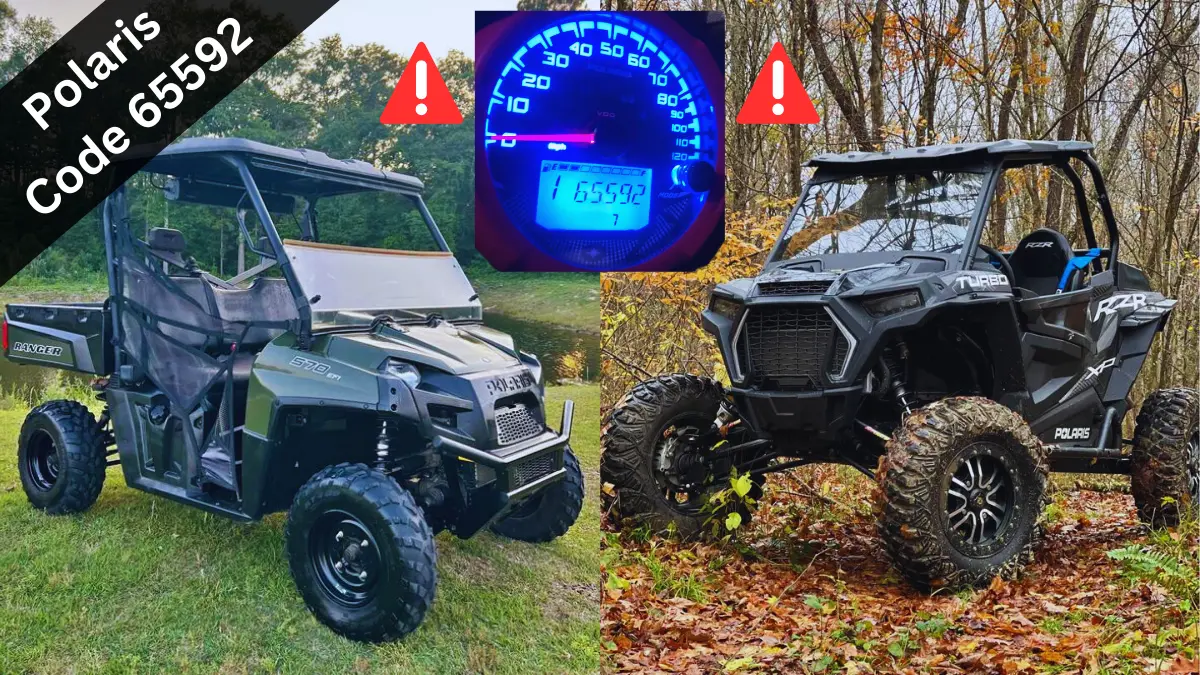Those of us who have owned a Polaris Ranger, Polaris RZR, or really any other Polaris vehicle for any amount of time know how annoying it can be to see the Check Engine light come on and have the vehicle go into limp mode.
Many times this Check Engine light is accompanied by an error code, or multiple error codes, to give us a sense of what the issue may be.
One of the most common of these is Polaris code 65592.
This guide will detail Polaris code 65592, including the following:
- What code 65592 means
- How serious it is
- The most common reasons it appears
- If it’s safe to keep driving while the code is displayed
- How this code can be cleared
- How you can be sure your vehicle is good once it’s cleared
Polaris Code 65592
Polaris code 65592 is a misfire code that references a misfire within the engine’s MAG side, with MAG standing for Magneto and being the side where electricity is generated for the ignition.
This code is very often accompanied by Polaris code 65590, which is a similar misfire code that references a random misfire somewhere in the engine.
Occasionally code 65592 will also be accompanied by code 65591, a misfire code that references a misfire to the opposite side of the engine, known as the PTO (Power Takeoff) side.
Though these error codes occur in most modern Polaris vehicles, they’re most prevalent in the Polaris Ranger and Polaris RZR models.
And they do only affect gas-powered models, so if you own a Polaris electric UTV you’re safe.

Why Does Polaris Code 65592 Occur?
If you’re seeing your Check Engine light come on accompanied by code 65592, your ECU is telling you that your RPMs are out of range at a certain speed or throttle level.
The most common causes of this are:
- Belt slippage
- Clutch issues related to the spyder rollers, torque, or dirt/grime build-up.
- Ignition issues stemming from the spark plugs, fuel injector, or fuel pump
- Valve compression is off
- Fuel issues
If you’ve made any upgrades or adjustments to any of these components recently, there’s a good chance that’s what’s triggering this misfire code.
And the code will likely remain until your RPMs are back in range.
However, there are some instances where this code has displayed in error and has been cleared by way of a simple fix.
Polaris Code 65592 & Overcoming Limp Mode
When you get a misfire code on your vehicle, it will almost always go into Limp Mode.
Limp mode essentially bogs the vehicle down so that your vehicle can’t reach anywhere close to its top speed.
If this happens to you, you generally don’t want to drive very far while in Limp Mode.
To overcome Limp Mode, stop your vehicle and shut it off completely, letting it sit for between 30 and 60 seconds.
When you fire it back up, Limp Mode should be eliminated and you should be able to drive regularly again.
But your Check Engine light and the accompanying error code will likely still display on your dash.
How To Clear Code 65592
Assuming the code still remains when you restart your vehicle, slowly drive it between 5-10 mph until your ECU no longer senses any faults.
Once this happens, the code should clear on its own.
The distance you’ll need to slowly drive before this happens will vary, but can take as short as thirty seconds or as long as thirty minutes or more.
If Limp Mode Or The Code Won’t Go Away
If you attempt the fix above but your vehicle goes back into Limp Mode upon restarting it, you can be pretty sure you have a real issue.
Similarly, if the error code or codes will not seem to clear after restarting and driving around slowly, your ECU is still sensing a fault with the RPMs which signifies you have a real issue.
Either way, you’ll need to do some investigating into what’s causing the issue, and there are some best places to start.
Most Common Causes of Polaris Code 65592
There are quite a few factors that can cause a fault in your vehicle’s RPMs.
If you’re experiencing misfire codes after recently modifying components such as your vehicle’s clutch system, gearing, or tires, you likely just need a tune of the ECU to account for this.
An ECU tune will recalculate the proper air to fuel ratios needed at each RPM range and throttle position, and then apply them.
This is usually enough to prevent or overcome any misfire codes after modifications.
A highly recommended ECU tune for Polaris Vehicles is that of Gilomen Innovations, which was made specifically to prevent and eliminate these misfire issues and fault codes.
If you’ve not made modifications recently, code 65592 likely signals an issue with one of the following:
- Drive belt
- Clutch
- Ignition
- Valves
- Fuel
Drive Belt Related Misfires
The most common cause of Polaris code 65592 is an issue caused by the drive belt.
A drive belt related misfire may happen due to any of the following:
- Belt slippage
- Belt cogs missing
- Belt glazing
- Belt burning
- Belt hourglassing
If your vehicle’s drive belt is slipping, it will cause the crankshaft to rotate faster than it should and the RPMs to surge. This will commonly trigger a misfire code.
The first place to start investigating if code 65592 flashes on your display is the belt. Check to ensure that it is not suffering from any missing cogs, glazing, burns, or hourglassing.
If your belt shows any signs of these flaws or appears in rough shape, you should replace it. Many times this will fix your problem.
Even so, you should keep in mind that a damaged belt is usually the victim of some other underlying issue and replacing it may only solve this issue temporarily.
Clutch System Misfires
The clutch system is most often the cause of damaged belts and belt slippage, usually due to the following:
- Spyder rollers failing
- Primary clutch not properly torqued
- Clutch system needs cleaning
The stock spyder rollers in some Polaris UTVs are prone to failure, which results in the belt being damaged from rubbing against the sides of the clutch.
You should inspect these rollers before simply replacing your belt, as if they are failing they will cause the same damage to a new belt before long.
You’ll also want to ensure the primary clutch is not loose and spinning on the crankshaft, which will lead to issues as well.
Clutch systems are also quite prone to dirt and grime building up in them over short periods of time.
Since this can also cause issues, a best practice is to blow out the primary and secondary clutches around every 300 miles of riding, which will keep them clean.
Ignition Misfires
As code 65592 signifies misfires from the side of the engine responsible for supplying electricity to the ignition, ignition-related misfires are also a common culprit and are usually caused by:
- Spark plug(s)
- Spark plug wires
- Defective fuel pump
- Defective fuel injector
If you have a spark plug issue, you’ll probably know it as you can generally feel an actual misfire in the engine take place while attempting to fire up your vehicle.
But even if you don’t notice this, inspect the spark plugs for fouling either way and replace them if needed.
The spark plug wires can also cause misfire issues, so you can test them to be sure they read at 8K OHMS or less.
If your fuel pump or fuel injector are defective, they may be the cause as well.
Remove the hose from the fuel pump to test it, ensuring that fuel sprays out as it should.
To test the fuel injector, pull the injector out and point it at a cloth or towel. Turn the ignition on and make sure it sprays out a fine mist and not a stream.
Valve Related Misfires
Though less common, a loss of compression in your valves can also cause this misfire code.
You can test the valve compression to be sure. If the compression is between 150 and 180 lbs and is close to equal in both cylinders, you should be good to go.
If there’s more than a 10% difference in compression between your cylinders, your valve clearances are likely off.
This usually happens as a result of one or both of them tightening or loosening too much. You should adjust them to their proper clearances if this is the case.
Fuel Misfires
If enough water finds its way into the fuel tank, it can cause a misfire when sucked into the fuel pump.
Refraining from using ethanol-based fuel will decrease the probability of this happening.
You should also strictly use high octane fuel in Polaris vehicles, which will help to avoid this as well.
Final Thoughts
If you run into Polaris code 65592 there’s likely an underlying issue with your drive belt, clutch system, ignition components, valves, or fuel.
For more on some of the common flaws found in Polaris machines, have a look at the following guides before you go:


